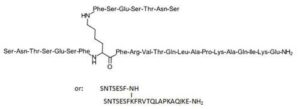This product is for research use only, not for human use. We do not sell to patients.

| Size | Price | Stock |
|---|---|---|
| 100mg | $1575 | In Stock |
| 200mg | $2360 | In Stock |
| 1μg | $3980 | In Stock |
Cat #: V3096 CAS #: 1353563-85-5 Purity ≥ 95%
Description: AUNP-12 (also known as Aur-012, Aurigene-012, and Aurigene NP-12), a novel and potent immune checkpoint modulator developed by Aurigene Discovery Technologies, is an inhibitor of the PD-1 signalling pathway with an EC50 of 0.72 nM in the inhibition of binding PD1 to PD-L2 using hPDL2 expressing HEK293 cells, and an EC50 of 0.41 nM in a rat peripheral blood mononuclear cells (PBMC) proliferation assay using hPDL1 expressing MDA-MB231 cells.
Publications Citing InvivoChem Products
Product Promise

- Physicochemical and Storage Information
- Protocol
- Related Biological Data
- Stock Solution Preparation
- Quality Control Documentation
| Molecular Weight (MW) | 3261.55 |
|---|---|
| Molecular Formula | C142H226N40O48 |
| CAS No. | 1353563-85-5 |
| Storage | -20℃ for 3 years in powder formr |
| -80℃ for 2 years in solvent | |
| Solubility In Vitro | DMSO: N/Ar |
| Water: ~100 mg/mL (30.6 mM)r | |
| Ethanol: N/A | |
| SMILES Code | OC(CC[C@H](NC([C@@H](NC([C@@H](NC([C@H](CCC(N)=O)NC([C@H](C)NC([C@@H](NC([C@@H]1CCCN1C([C@H](C)NC([C@H](CC(C)C)NC([C@H](CCC(N)=O)NC([C@@]([C@H](O)C)([H])NC([C@H](C(C)C)NC([C@H](CCCNC(N)=N)NC([C@H](CC2=CC=CC=C2)NC([C@H](CCCCNC([C@H](CC3=CC=CC=C3)NC([C@@H](NC([C@H](CCC(O)=O)NC([C@@H](NC([C@@H](NC([C@@H](NC([C@@H](N)CO)=O)CC(N)=O)=O)[C@H](O)C)=O)CO)=O)=O)CO)=O)=O)NC([C@@H](NC([C@@H](NC([C@@H](NC([C@H](CO)NC([C@H]([C@H](O)C)NC([C@H](CC(N)=O)NC([C@@H](N)CO)=O)=O)=O)=O)CCC(O)=O)=O)CO)=O)CC4=CC=CC=C4)=O)=O)=O)=O)=O)=O)=O)=O)=O)=O)CCCCN)=O)=O)=O)[C@@H](C)CC)=O)CCCCN)=O)C(N)=O)=O |
| Synonyms | Aurigene-012; Aur-012; Aurigene NP-12; Aurigene012; Aur012; Aurigene NP12; Aurigene 012; Aur 012; Aurigene NP 12 |
| Protocol | In Vitro | AUNP-12 is also able to significantly rescue recombinant human PD-L1 and PD-L2 mediated inhibition of in vitro human PBMC proliferation, with average EC50 values of 63.3 nM and 44.1 nM against PD-L1 and PD-L2 respectively. AUNP-12 rescues the proliferation in the mouse splenocyte assay system, with average EC50 values of 17 nM and 16.6 nM against rmPD-L1 and rmPD-L2 respectively. AUNP-12 displays equipotent antagonism toward PD-L1 and PD-L2 in rescue of lymphocyte proliferation and effector functions . |
|---|---|---|
| Animal model | Mouse with B16F10 melanoma tumor |
| Solvent volume to be added | Mass (the weight of a compound) | |||
|---|---|---|---|---|
| Mother liquor concentration | 1mg | 5mg | 10mg | 20mg |
| 1mM | 0.3066 mL | 1.5330 mL | 3.0660 mL | 6.1321 mL |
| 5mM | 0.0613 mL | 0.3066 mL | 0.6132 mL | 1.2264 mL |
| 10mM | 0.0307 mL | 0.1533 mL | 0.3066 mL | 0.6132 mL |
| 20mM | 0.0153 mL | 0.0767 mL | 0.1533 mL | 0.3066 mL |
This equation is commonly abbreviated as: C1 V1 = C2 V2
- (1) Please be sure that the solution is clear before the addition of next solvent. Dissolution methods like vortex, ultrasound or warming and heat may be used to aid dissolving.
- (2) Be sure to add the solvent(s) in order.




































